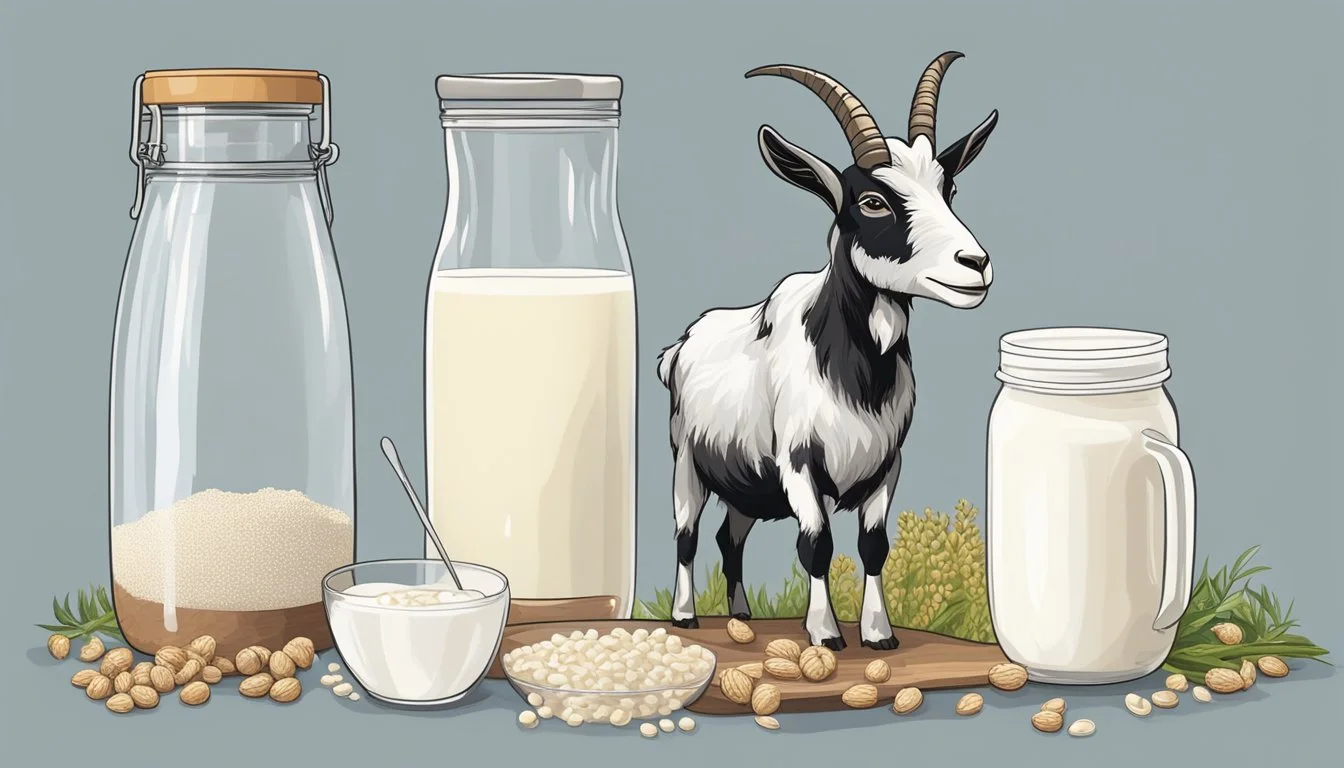Goat Milk Kefir
The Complete Guide to Crafting Your Homemade Probiotic Powerhouse
Goat milk kefir is a fermented milk drink that has been enjoyed for its taste and health benefits for centuries. Originating from the North Caucasus Mountains, it is traditionally made by adding kefir grains to goat milk which initiates the fermentation process. The result is a tangy, slightly effervescent beverage, rich in probiotics and enzymes.
The production of goat milk kefir involves a symbiotic culture of bacteria and yeast present in kefir grains working together to ferment the lactose in the milk. This not only gives kefir its distinctive flavor but also makes it generally well-tolerated by individuals with lactose sensitivity.
One of the key advantages of homemade goat milk kefir is the ability to control the fermentation time, which allows for customization of its taste and consistency. The process is straightforward and can be done with minimal equipment, making it accessible for anyone interested in incorporating this nourishing drink into their diet.
Understanding Goat Milk Kefir
Goat milk kefir is a fermented milk product known for its probiotic qualities and nutritional benefits. Engaging a specific process of fermentation, kefir transforms the natural sugars present in goat milk into a tart, slightly effervescent beverage that houses a multitude of beneficial microorganisms.
History and Origins
Goat milk kefir originated from the mountainous regions between Asia and Europe, where it has been a dietary staple for centuries. The traditional method involved kefir grains, a symbiotic colony of bacteria and yeasts, being added to goat milk, initiating the fermentation process. This practice was highly regarded for its supposed health-enhancing properties.
Nutritional Profile
Goat milk kefir is rich in various nutrients:
Proteins: It provides all essential amino acids, making it a complete protein source.
Vitamins: Kefir is a good source of B vitamins, particularly B12, and vitamin K2.
Minerals: High in calcium, magnesium, and phosphorus, kefir supports bone health and other bodily functions.
Probiotics: The fermentation introduces beneficial bacteria into the digestive tract, which can enhance gut health.
By contributing to the maintenance of a balanced gut microbiome, goat milk kefir supports overall digestive health and, by extension, the immune system. The lactic acid bacteria present in kefir grains convert lactose in milk to lactic acid, making it generally easier to digest, especially for those with lactose intolerance.
The Benefits of Goat Milk Kefir
Goat milk kefir stands out among fermented foods for its rich probiotic content and a multitude of health benefits that contribute to well-being.
Probiotic Powerhouse
Goat milk kefir is a fermented food teeming with probiotics, which are live microorganisms that confer a health benefit on the host when administered in adequate amounts. These beneficial bacteria play a fundamental role in maintaining gut health, and goat milk kefir is renowned for being an excellent probiotic source.
Probiotics: Helps in balancing the gut microbiome
Beneficial Bacteria: Strengthening the digestive tract
Digestive Health
The regular consumption of goat milk kefir can support healthy digestion, especially due to its ability to combat some digestive issues. Its probiotics aid the digestive tract and can alleviate symptoms of lactose intolerance by assisting in the breakdown of lactose.
Healthy Digestion: Optimizes nutrient absorption
Lactose Intolerance: May reduce symptoms due to fermentation
Immune Boosting Effects
Goat milk kefir's positive impact on the immune system cannot be understated, as much of the immune system is located within the gut. The probiotics found in this fermented food can reinforce the body's natural defenses.
Immune System: Strengthens immune response
Fermented Foods: Support overall immune health
Starting Your Kefir Journey
Embarking on the journey of making homemade kefir involves a few fundamental steps: obtaining quality kefir grains and selecting the right type of milk. These initial decisions lay the groundwork for a successful kefir-making process.
Getting Started with Kefir Grains
To begin making homemade kefir, one must first acquire kefir grains. These grains are a symbiotic culture of yeast and bacteria, essential for fermenting the milk into kefir. They aren't actual "grains" but rather resemble small, gelatinous beads. When starting, one can source kefir grains from a reputable health food store or an online retailer specializing in fermentation supplies. It is important to choose fresh, active kefir grains for the most robust fermentation. The quality of the grains significantly affects both the flavor and probiotic content of the kefir.
For maintenance, the grains should be placed in a clean jar with the desired amount of milk. They will ferment the milk at room temperature, generally within 24 hours. After the fermentation is complete, the grains are strained from the liquid kefir and can be immediately used to start another batch.
Selecting Your Ingredients
The choice of milk plays a pivotal role in kefir production. For traditionalists aiming to make goat milk kefir, it's imperative to select fresh or pasteurized goat milk. Raw milk can also be used, but it's crucial to understand the potential risks and ensure it's obtained from a safe, clean source. Ultra-pasteurized milk types are less ideal as the high-temperature processing can compromise the fermenting capability of the milk. Some may choose cow milk due to its wider availability, and for the dairy-free option, coconut milk serves as a viable alternative.
When selecting milk, one should consider taste preference, availability, and dietary needs. Freshness is key, and the milk should not contain additives or preservatives that might inhibit the fermentation process.
Goat Milk: Traditional choice, distinct flavor
Cow Milk: Widely available, milder taste
Coconut Milk: Non-dairy, requires adaptation in process
Raw Milk: Natural state, may have more enzymes
Pasteurized Milk: Safer than raw, retains fermentability
Ultra-Pasteurized: Not recommended, fermentation may be impaired
Using these guidelines, one can confidently start their kefir journey, creating a nutritious, probiotic-rich beverage in the comfort of their own home.
The Art of Fermentation
In the creation of goat milk kefir, mastering the fermentation process is crucial for achieving the right taste and consistency. It is a balance of time, temperature, and the symbiotic action of bacteria and yeast.
Setting Up the Process
Begin by procuring kefir grains, a combination of bacteria and yeast essential for fermenting the lactose in the milk. In a glass jar, add the grains to the goat milk; ensure the use of non-reactive materials such as glass or stainless steel to avoid unwanted reactions during fermentation.
1. Pour goat milk into the jar, leaving some space at the top for expansion. 2. Gently stir the mixture to evenly distribute the kefir grains.
It's important to cover the jar with a breathable material, like a coffee filter or cloth, secured with a rubber band to allow for air circulation while preventing contaminants.
Understanding Fermentation Stages
First Stage: During fermentation, the ecosystem of yeast and bacteria strains in the kefir grains becomes active, which may last anywhere from 12 to 48 hours depending on the ambient room temperature. As the culture works, the milk transforms; it starts to thicken and the taste becomes tart and acidic.
List of indicators for the first stage:
Slight thickening of the milk
Development of a tangy flavor
Second Stage: Continuing the process, the fermentation can intensify the flavors, making them more robust and complex. The kefir achieves a richer texture and may separate into curds and whey – a sign of thorough fermentation.
Key indicators for the second stage:
Pronounced thickened consistency
Presence of clear whey, often at the bottom or sides of the jar
Throughout both stages, it's essential to maintain moderate heat—around room temperature—to ensure optimal growth conditions for the kefir culture. The process is complete when the kefir has achieved its characteristic texture and flavor, which should be tart yet pleasant.
Optimizing Kefir Quality
Preparing goat milk kefir of exceptional quality requires attention to texture and flavor. The process allows for personalization, and understanding the nuances of these elements can significantly enhance the kefir experience.
Texture and Consistency
Texture:
Smoothie: For a kefir smoothie, maintain a balance between thickness and drinkability. One ensures a velvety texture by not over-fermenting the kefir, which can lead to separation and a grainy feel.
Recipe Consistency: Consistency in the kefir-making recipe is vital. Standardize the amount of kefir grains and goat milk, and keep the fermentation period consistent to achieve a predictable texture every time.
Secondary Fermentation:
Creaminess: To enhance creaminess, a second fermentation can be employed. After straining the grains, let the kefir ferment for another few hours, which can improve texture.
Sugar Content: Introducing a small quantity of sugar or honey during this phase can feed the bacteria, leading to a slightly thicker kefir.
Flavor and Aroma
Base Flavor:
Natural Sweeteners: Subtle sweetness can be achieved by adding natural sweeteners like honey which complements the kefir's tanginess.
Lemon: A hint of lemon can be introduced for a fresh, zesty note, balancing the kefir's inherent flavors.
Second Fermentation and Flavoring:
Fruit Addition: Incorporating fruit during the second fermentation imparts natural sweetness and a bouquet of flavors.
Ginger or Spices: Infusing the kefir with ginger or other warm spices during the second fermentation can introduce a subtle, intriguing spice backdrop.
The key is to be judicious; overly powerful flavorings can overwhelm the delicate nature of goat milk kefir.
Remember, personal taste dictates the preferred balance of sweetness and tanginess, guiding the choice of ingredients and the length of fermentation.
Advanced Kefir Techniques
Advanced kefir techniques enhance both the flavor and nutritional profile of traditional kefir. These methods involve additional steps after the initial fermentation, allowing for versatility and experimentation with different ingredients and cultures.
Mastering Second Fermentation
Second fermentation is the process that follows the primary fermentation of kefir. To accomplish this, one must first remove the kefir grains after the initial ferment. The kefir is then flavoured with ingredients such as fruit, honey, or spices and left to ferment for another 12 to 48 hours without the grains. This not only infuses the kefir with new flavors but can also increase the carbonation and probiotic content.
For example, adding pureed raspberry to goat milk kefir can introduce a bright, tangy flavor profile and further boost the drink's benefits as a probiotic food. However, this requires careful monitoring to prevent over-fermentation, which can lead to an overly sour taste or excessive buildup of carbonation.
Kefir Variations and Experiments
Kefir can be modified using various milks, such as cow milk or goat milk, which each impart unique flavors and textures. Experimenting with non-dairy kefir is another advanced technique that caters to those with dairy sensitivities or vegetarian diets. Alternatives like coconut milk or almond milk can be used, although these may demand specific non-dairy kefir grains or a mesophilic culture for successful fermentation.
In venturing into water kefir, an entirely different set of grains are used, known as water kefir grains. This variety is ideal for crafting a lighter, refreshing probiotic beverage that can be flavored similarly to milk-based kefir, yet without the use of dairy, suiting those looking for vegan probiotic options. It's crucial to note, however, that water kefir and milk kefir grains are not interchangeable due to their different compositions and fermenting environments.
Moreover, the fermentation period, temperature, and ratios can be adjusted to tailor the consistency and strength of the kefir, thereby refining its characteristics to personal preferences while still reaping its numerous health benefits.
Incorporating Kefir Into Your Routine
Goat milk kefir can effortlessly become a staple in one's diet due to its versatility and probiotic benefits. By adopting kefir into daily consumption and exploring its culinary potential through recipes, individuals can enrich their routine with this healthful beverage.
Daily Consumption and Health
Kefir, a probiotic-rich beverage, stands out as a superior alternative to traditional yogurt. With its higher probiotic content, incorporating a daily serving of kefir can support digestive health and enhance immunity. Individuals may find goat milk kefir at their local health food store or decide to make it at home. Simple incorporation tactics may include:
A morning smoothie: Blend kefir with fruits and greens for a nutritious start to the day.
An evening treat: Substitute dessert with a bowl of kefir topped with honey or fruit for a light end to the evening.
Creative Kefir Recipes
Beyond drinking it straight, those looking to expand their culinary repertoire can integrate kefir into a variety of recipes. Here are two methods to try:
Kefir Cheese:
Strain kefir to separate the whey and achieve a soft, spreadable cheese.
Season with herbs and use as a dip or sandwich spread.
Kefir Salad Dressing:
Whisk kefir with olive oil, lemon juice, and spices to create a tangy dressing.
Drizzle over salads for a dose of gut-friendly goodness.
With these approaches, kefir seamlessly blends into daily routines, contributing to health while offering a refreshing taste.
Troubleshooting Common Kefir Issues
When making goat milk kefir, challenges may arise with the texture and flavor, as well as with preventing mold and contamination. Having the right strategies for troubleshooting these issues ensures both the quality and safety of the kefir.
Texture and Flavor Challenges
If the goat milk kefir is too sour or has a rubbery and translucent appearance, it may be due to over-fermentation. To mitigate this, one should reduce the fermentation time or the ratio of kefir grains to milk. Here are specific steps:
Reduce sourness: Shorten the fermentation period to prevent excessive acidity. A taste test during the fermentation process can provide accuracy in achieving the desired flavor.
Improve rubbery texture: Decrease the amount of kefir grains used. Too many grains can accelerate fermentation, causing a rubbery texture.
By taking these steps, one can adjust the fermentation to yield the desired texture and taste.
Mold and Contamination Prevention
To prevent mold and contamination:
Avoid direct sunlight: Store kefir grains and fermenting milk away from direct sunlight, as it can promote unwanted bacterial growth.
Cleanliness is crucial: Use clean utensils and containers to prevent the introduction of mold spores.
Assure the environment for culturing kefir is clean and well-maintained to help maintain a healthy balance of bacteria and yeast during fermentation.
Kefir Storage and Maintenance
When making kefir, it's essential to use proper storage techniques to ensure the longevity of kefir grains and the quality of the kefir. Below are detailed steps to effectively store kefir and maintain its cultures.
Proper Storage Techniques
Once kefir has fermented, it should be stored in a glass jar to prevent reactions with the kefir's acidity. The mason jar is a popular choice, commonly used due to its wide mouth and durable quality. To preserve the kefir's taste and prevent further fermentation, place it in the refrigerator. Use a plastic lid to seal the jar as metal lids can corrode over time due to the kefir's acidity. Always ensure the lid is sealed tightly to maintain freshness and prevent any off-flavors from developing.
Maintaining Kefir Cultures
For a continuous supply of kefir, kefir grains must be maintained properly. After fermenting, the kefir requires straining with a plastic strainer, as metal could damage the grains. Gently stir the kefir with a wooden spoon during the straining process to separate the grains from the liquid. After straining, the grains should be placed in a clean container and covered with fresh milk. This container, preferably a glass or plastic jar, should then be covered loosely with a lid or cloth and allowed to ferment at room temperature for the next batch. Remember to avoid using metal utensils or containers, as they can potentially harm the kefir cultures.
Sharing and Scaling Up
When one masters the art of making homemade kefir, the next steps often involve sharing the nutritious fermented milk with others and potentially increasing production. This requires attention to detail and careful planning to ensure the quality and safety of the kefir.
Sharing Kefir with Others
Homemade kefir can be a delight to share with friends, family, or even through a kefir stand. When sharing, it's essential to use glass jars to store kefir as they do not react with the fermented milk and can be sealed tightly to maintain freshness. A brief instructional note or a verbal explanation on how to store and consume kefir could greatly aid those new to kefir in appreciating its benefits. Some enthusiasts might find an online community or local health food store a good starting point to share their kefir knowledge or distribute excess grains.
Scaling Up Production
For those interested in scaling up kefir production, investing in high-quality stainless steel utensils can be beneficial for handling larger volumes safely. Stainless steel is durable and does not interact with the fermenting kefir. Moreover, maintaining a clean environment is crucial when working with a larger production to avoid contamination. Keeping a steady room temperature and adhering to proper fermentation times ensures consistency in taste and texture. It may also be worthwhile to explore local regulations around selling homemade food products if considering commercial sharing.
Conclusion
Goat milk kefir is a fermented dairy product recognized for its probiotic content and potential health benefits, particularly relating to digestion. Made by adding kefir grains to goat milk, this beverage encourages the growth of beneficial bacteria and yeasts, contributing to a rich and diverse microbiota.
Key Points:
Probiotic Powerhouse: Goat milk kefir contains a multitude of probiotics crucial for healthy digestion and overall well-being.
Self-Made Satisfaction: Crafting kefir at home allows for customization and ensures a fresh supply of these probiotics.
For those seeking improved gut health and a nutritious addition to their diet, goat milk kefir presents a viable option. Its nutritional profile and digestive benefits make it an excellent choice. As with introducing any new food, individuals should start with small amounts to gauge their body's response.
While goat milk kefir can be a delightful experience with its tangy flavor, one should always prioritize safety and hygiene during preparation. Properly handled and prepared, homemade goat milk kefir is a testament to the synergy between taste and health.










